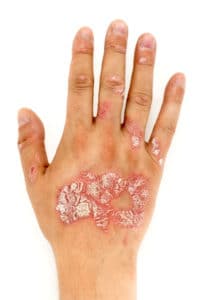By Eva Briggs
 My brother was a musician who started out as a classical guitarist. He had to switch to jazz because he had psoriasis. Wait, you might ask, psoriasis is a skin disease. What does that have to do with guitar playing?
My brother was a musician who started out as a classical guitarist. He had to switch to jazz because he had psoriasis. Wait, you might ask, psoriasis is a skin disease. What does that have to do with guitar playing?
My brother developed brittle, pitted, ridged fingernails from his psoriasis. Classical guitar players need long fingernails on their right hand. No longer able to grow long fingernails, he changed his specialty to jazz. You can also learn guitar lessons in houston for further knowledge to guitars.
Psoriasis is characterized by red scaly patches on the skin. It’s an autoimmune disease, meaning the body’s immune system attacks its own tissues. This prompts the skin to build up more and more skin cells, forming the thickened plaques. It’s a chronic condition, worsening at times, and easing up at other times.
Like many other autoimmune diseases, it arises from a combination of underlying genetic susceptibility plus environmental factors.
Some known factors that may trigger psoriasis include infections, skin injury, stress, smoking, heavy alcohol use, vitamin D deficiency and certain medicines.
Approximately 2% to 4% of the population has psoriasis. It affects men and women equally. It most often starts in adulthood, but it can start in children.
There are five main types of psoriasis.
n Plaque psoriasis, the most common form, consists of dry raised red skin lesions covered with silvery scales. It may be itchy or painful and can occur anywhere on the body.
n Guttate psoriasis appears as small, round, dot-like lesions. This accounts for 10% of psoriasis and often starts in children or young adults. It may be triggered by a strep throat infection. The word guttate comes from the Latin word “gutta” which means drop.
n Inverse psoriasis produces bright red lesions in body folds such as under the arm, behind the knee, or in the groin. Patients with this type of psoriasis often have another type elsewhere on their body.
n Pustular psoriasis consists of blisters filled with noninfectious pus surrounded by red skin. The pus contains white blood cells, but no infectious agents and it is not contagious. It occurs most often on the hands or feet.
n Erythrodermic psoriasis is a very severe form leading to widespread redness over most of the body. It can cause severe pain and itching and cause the skin to come off in sheets. It is potentially life-threatening. Fortunately, it is rare.
In addition to nail changes, psoriasis can be associated with arthritis. Psoriatic arthritis causes joint pain, swelling and stiffness. This arthritis can occur even without visible psoriasis skin lesions. One manifestation is painful, sausage-like swelling of fingers or toes.
Patients with psoriasis have a higher risk of many other diseases, including eye disorders, obesity, Type 2 diabetes, high blood pressure, heart disease, other autoimmune diseases, Parkinson’s disease, and kidney disease. There is also a slightly higher risk of several types of cancer.
Although psoriasis can’t be cured, there are many treatments. The most frequently prescribed treatments for mild to moderate psoriasis are topical corticosteroids. Long-term use can cause skin thinning and topical corticosteroids might stop working over time. So they are usually used for short-term treatment during flares.
There are many other topical medicines for psoriasis. Vitamin D analogs, synthetic forms of vitamin D, are available in prescription creams or solutions. Anthralin is a medicine that can remove scales and make the skin smoother. It may irritate the skin and it stains anything it touches. Topical retinoids are vitamin A derivatives that can decrease skin inflammation. These can irritate the skin and increase sensitivity sunlight. Calcineurin inhibitors reduce inflammation and plaque buildup but are not recommended for long-term use due to an increased risk for skin cancer and lymphoma. Salicylic acid is available both in nonprescription and stronger prescription forms. It promotes shedding of dead skin cells to reduce scaling. Coal tar reduces scaling, itching and inflammation. But it’s messy, stains clothing and bedding, and has a strong odor. Moisturizing creams are useful addition to other medicines as they can lock in moisture to reduce itching, scaling, and dryness.
Phototherapy uses natural or artificial ultraviolet light. Brief daily exposures to sunlight can be helpful, but patients should check with their doctors for the safest way to reap the benefits of sunlight while minimizing risks of skin damage. Various types of controlled doses of UVB (ultraviolet B) artificial light forms another treatment. Goeckerman therapy combines UVB and coal tar. Psoralen plus ultraviolet A (PUVA) combines a light sensitizing medication called psoralen with ultraviolet A light. Psoralen makes the skin more sensitive to UVA, and UVA penetrates the skin more deeply than UVB. This aggressive treatment is reserved for severe psoriasis due to side effects. Excimer laser uses a controlled beam of UVB light directed at psoriasis plaques.
For severe or resistant psoriasis, there are oral and injected forms of medicine. Retinoids, related to vitamin A, can be used for severe psoriasis. Side effects include lip inflammation and hair loss. These medicines increase the risk of birth defects. Methotrexate suppresses inflammation and decreases the production of skin cells. It can also help psoriatic arthritis. Cyclosporine suppresses the immune system but can only be used for short term. Biologics are drugs that are targeted to alter the immune system.
With so many potential treatments for psoriasis, patients should become established with a dermatology expert to determine the best treatment in their case.
As for my brother, he went on to a successful career as a jazz performer, music teacher, and music store owner until he died too young — from leukemia.
Eva Briggs is a medical doctor who works at two urgent care centers in the Syracuse region.

